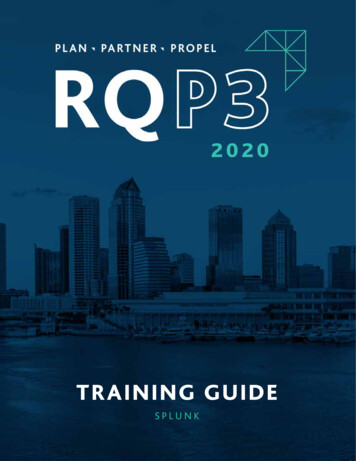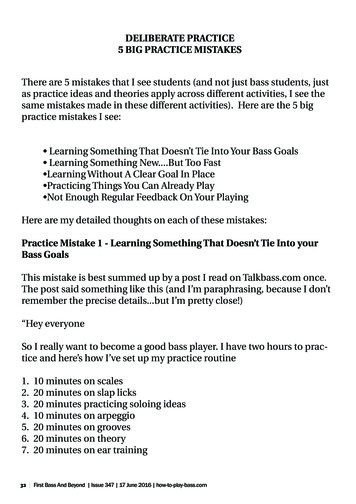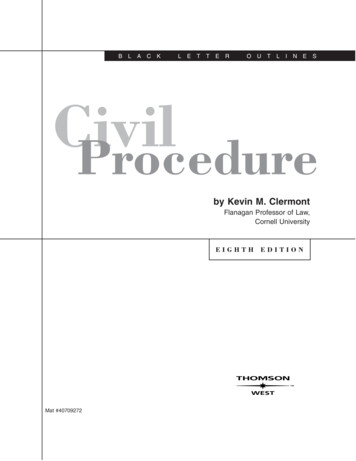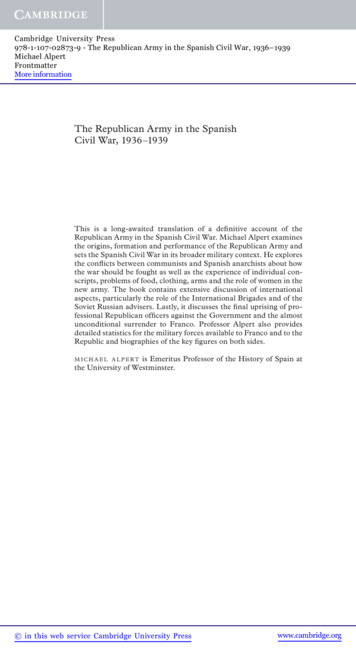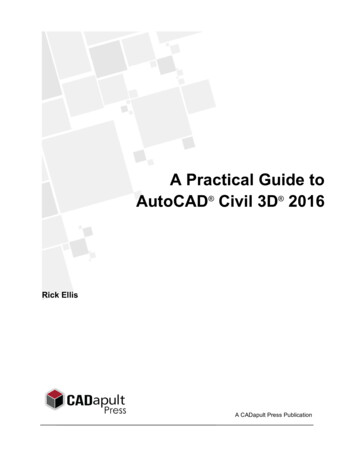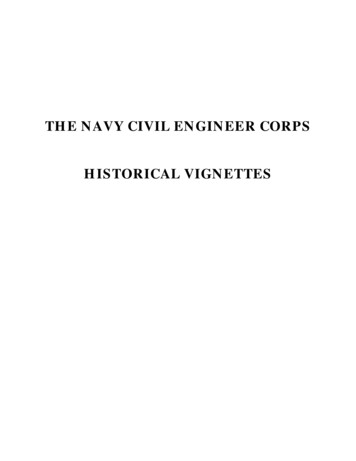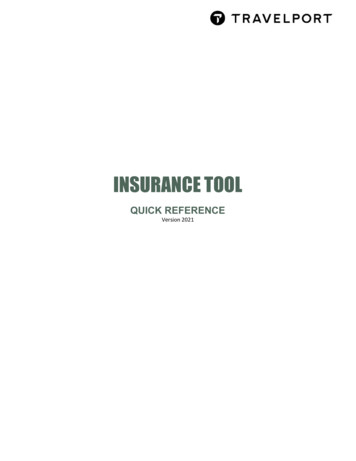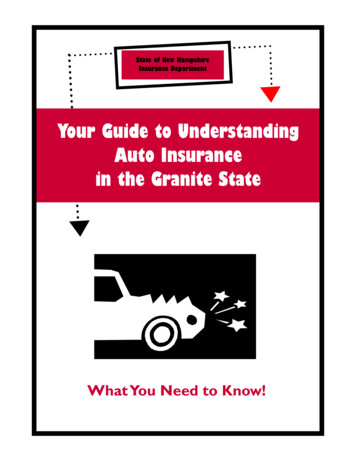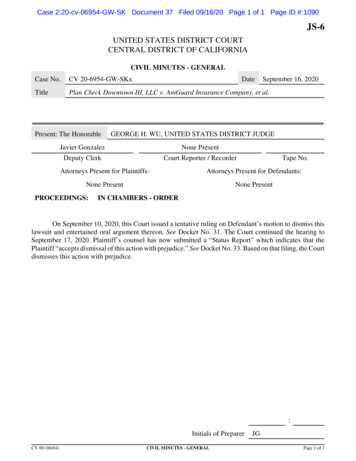
Transcription
Case 2:20-cv-06954-GW-SK Document 37 Filed 09/16/20 Page 1 of 1 Page ID #:1090JS-6UNITED STATES DISTRICT COURTCENTRAL DISTRICT OF CALIFORNIACIVIL MINUTES - GENERALCase No.CV 20-6954-GW-SKxTitlePlan Check Downtown III, LLC v. AmGuard Insurance Company, et al.Present: The HonorableDateSeptember 16, 2020GEORGE H. WU, UNITED STATES DISTRICT JUDGEJavier GonzalezNone PresentDeputy ClerkCourt Reporter / RecorderTape No.Attorneys Present for Plaintiffs:Attorneys Present for Defendants:None PresentNone PresentPROCEEDINGS:IN CHAMBERS - ORDEROn September 10, 2020, this Court issued a tentative ruling on Defendant’s motion to dismiss thislawsuit and entertained oral argument thereon. See Docket No. 31. The Court continued the hearing toSeptember 17, 2020. Plaintiff’s counsel has now submitted a “Status Report” which indicates that thePlaintiff “accepts dismissal of this action with prejudice.” See Docket No. 33. Based on that filing, the Courtdismisses this action with prejudice.:Initials of PreparerCV-90 (06/04)CIVIL MINUTES - GENERALJGPage 1 of 1
Case 2:20-cv-06954-GW-SK Document 33 Filed 09/15/20 Page 1 of 2 Page ID #:1067123456Kathryn Lee Boyd (SBN 189496)lboyd@hechtpartners.comJanine F. Cohen (SBN 203881)jcohen@hechtpartners.comHecht Partners LLP125 Park Ave. 25th FloorNew York, NY 10017Telephone: 212-851-6821Facsimile: 646-492-5111789Attorneys for Plaintiff Plan Check DowntownIII, LLC, and others similarly situated,UNITED STATES DISTRICT COURT10FOR THE CENTRAL DISTRICT OF CALIFORNIA111213PLAN CHECK DOWNTOWN III, LLC, aCalifornia limited liability company andothers similarly situated,141516171819Case No: 2:20-cv-06954STATUS REPORT RE: DISMISSALWITH PREJUDICEPlaintiff,v.AMGUARD INSURANCE COMPANY, aPennsylvania company, and DOES 1 through20,Defendants.202122232425262728STATUS REPORT
Case 2:20-cv-06954-GW-SK Document 33 Filed 09/15/20 Page 2 of 2 Page ID #:10681Pursuant to the Court’s decision at the Telephonic Hearing on Defendant’s2Motion to Dismiss held on September 10, 2020, Plaintiff Plan Check Downtown3III, LLC hereby accepts dismissal of this action with prejudice.45Dated: September 15, 2020Hecht Partners LLP678910111213By:Kathryn Lee Boyd (SBN 189496)lboyd@hechtpartners.com125 Park Avenue, 25th FloorNew York, NY 10017Telephone: 212-851-6821Attorneys for Plaintiff Plan CheckDowntown III, LLC, and otherssimilarly situated,1415161718192021222324252627281STATUS REPORT
Case 2:20-cv-06954-GW-SK Document 31 Filed 09/10/20 Page 1 of 10 Page ID #:1028UNITED STATES DISTRICT COURTCENTRAL DISTRICT OF CALIFORNIACIVIL MINUTES - GENERALCase No.CV 20-6954-GW-SKxTitlePlan Check Downtown III, LLC v. AmGuard Insurance Company, et al.Present: The HonorableDateSeptember 10, 2020GEORGE H. WU, UNITED STATES DISTRICT JUDGEJavier GonzalezTerri A. HouriganDeputy ClerkCourt Reporter / RecorderTape No.Attorneys Present for Plaintiffs:Attorneys Present for Defendants:Kathryn L. BoydJanine F. CohenChet A. KronenbergPROCEEDINGS:TELEPHONIC HEARING ON DEFENDANT'S MOTION TO DISMISS[8]The Court’s Tentative Ruling is circulated and attached. Court and counsel confer. For reasons stated onthe record, the Court continues the motion to September 17, 2020 at 8:30 a.m.:Initials of PreparerCV-90 (06/04)CIVIL MINUTES - GENERAL18JGPage 1 of 1
Case 2:20-cv-06954-GW-SK Document 31 Filed 09/10/20 Page 2 of 10 Page ID #:1029Plan Check Downtown III v. AmGuard Insurance Company et al; Case No. 2:20-cv-06954-GW-(SKx)Tentative Ruling on Defendant’s Motion to DismissI.Background1Like many other restaurateurs across the country, plaintiff Plan Check Downtown III hasseen its business suffer greatly since the onset of the ongoing COVID-19 pandemic. In responseto various city- and state-government orders requiring restaurants to suspend on-premise diningand individuals to shelter at home, Plan Check stopped all operations at its two restaurant locationsin Los Angeles in March 2020. Compl. ¶ 43. While its West Los Angeles location has sincereopened for take-out and delivery service, its downtown location remains closed. Id.Prior to these events, Plan Check had purchased a property insurance policy from defendantAmGuard Insurance Company (the “Policy”) for its two restaurants. Id. ¶ 14. The Policy providescoverage for, among other things, loss of business income due to the necessary suspension ofbusiness operations due to any “physical loss of or damage to” the covered properties. See Policy§ I.A.5(f). Plan Check argues that its loss of business income caused by the changes to itsoperations is covered by the Policy and submitted a claim to AmGuard for reimbursement. Compl.¶ 50. AmGuard rejected the claim, concluding that Plan Check had not suffered a physical loss ordamage to its properties and that in any event a “virus exclusion” in the Policy meant that PlanCheck’s claims were not covered. Id. ¶ 52.After AmGuard’s denied its claim, Plan Check brought this putative class action againstAmGuard on behalf of all restaurants in California that purchased comprehensive businessinsurance coverage from AmGuard. Id. ¶ 64. Plan Check filed its lawsuit in California state court,alleging a breach of contract and other related claims. AmGuard removed the case to federal courtbased on diversity jurisdiction. See NoR at 2-5. Before the Court is AmGuard’s motion to dismissfor failure to state a claim.II.Legal StandardUnder Rule 12(b)(6), a defendant may move to dismiss for failure to state a claim uponwhich relief can be granted. Fed. R. Civ. P. 12(b)(6). A complaint may be dismissed for failure1The following abbreviations are used for the filings: (1) Notice of Removal (“NoR”), ECF No. 1; (2)Complaint (“Compl.”), ECF No. 1-1; (3) Business Owner’s Coverage Form (“Policy”), ECF No. 10-1; (4) Defendant’sMotion to Dismiss (“Mot.”), ECF No. 8; (5) Plaintiff’s Opposition to Motion to Dismiss (“Opp.”), ECF No. 17; (6)Defendant’s Reply in Support of Motion to Dismiss (“Reply”), ECF No. 21.1
Case 2:20-cv-06954-GW-SK Document 31 Filed 09/10/20 Page 3 of 10 Page ID #:1030to state a claim for one of two reasons: (1) lack of a cognizable legal theory; or (2) insufficientfacts under a cognizable legal theory. Bell Atl. Corp. v. Twombly, 550 U.S. 544, 555 (2007); seealso Mendiondo v. Centinela Hosp. Med. Ctr., 521 F.3d 1097, 1104 (9th Cir. 2008).The court must construe the complaint in the light most favorable to the plaintiff, byaccepting all well-pled allegations of material fact as being true, and drawing all reasonableinferences from well-pleaded factual allegations in favor of the plaintiff. Gompper v. VISX, Inc.,298 F.3d 893, 896 (9th Cir. 2002). The court is not required to accept as true legal conclusionscouched as factual allegations. Ashcroft v. Iqbal, 556 U.S. 662, 678 (2009). While a complaintdoes not need detailed factual allegations to survive a Rule 12(b)(6) motion, the plaintiff mustprovide grounds demonstrating its entitlement to relief. Twombly, 550 U.S. at 555 (2007). Underthe Supreme Court’s decisions in Twombly and Iqbal, this requires that the complaint contains“sufficient factual matter . . . to ‘state a claim to relief that is plausible on its face.’” Iqbal, 556U.S. at 678 (quoting Twombly, 550 U.S. at 570).III.DiscussionThe parties agree that the Policy is governed by California law. See generally StonewallSurplus Lines Ins. Co. v. Johnson Controls, Inc., 14 Cal.App.4th 637, 718-21 (1993) (principallocation of insured risk is most important consideration in determining which state’s law appliesto insurance policy); Restatement (Second) of Conflict of Laws § 193 (rights created by policy aredetermined by the local law of the state which the parties understood was to be the principallocation of the insured risk).“When determining whether a particular policy provides a potential for coverage,” a court“[is] guided by the principle that interpretation of an insurance policy is a question of law.” Wallerv. Truck Ins. Exch., Inc., 11 Cal.4th 1, 18 (1995). “[A]ny ambiguity or uncertainty in an insurancepolicy is to be resolved against the insurer and . . . if semantically permissible, the contract will begiven such construction as will fairly achieve its object of providing indemnity for the loss to whichthe insurance relates.” Reserve Ins. Co. v. Pisciotta, 30 Cal.3d 800, 807 (1982). The purpose is“to protect the insured’s reasonable expectation of coverage in a situation in which the insurerdraftsman controls the language of the policy.” Id. at 808. “Whereas coverage clauses areinterpreted broadly so as to afford the greatest possible protection to the insured, exclusionaryclauses are interpreted narrowly against the insurer.” Id.A. The terms of the insurance policy2
Case 2:20-cv-06954-GW-SK Document 31 Filed 09/10/20 Page 4 of 10 Page ID #:1031In the Policy, AmGuard promises that “[it] will pay for direct physical loss of or damageto Covered Property . . . caused by or resulting from any Covered Cause of Loss.” Policy § I.A.It goes on to provide a subsection titled “Additional Coverages,” which specifies some coveredcauses of loss. Relevant here, that section includes:Section I – PropertyA. CoverageWe will pay for direct physical loss of or damage to Covered Property at the premisesdescribed in the Declarations caused by or resulting from any Covered Cause of Loss.***5. Additional Coveragesf. Business Income. . . We will pay for the actual loss of Business Income you sustain due to thenecessary suspension of your ‘operations’ during the ‘period of restoration.’ Thesuspension must be caused by direct physical loss of or damage to property at thedescribed premises. The loss or damage must be caused by or result from a CoveredCause of Loss.***g. Extra Expense(1) We will pay necessary Extra Expense you incur during the “period ofrestoration” that you would not have incurred if there had been no direct physicalloss or damage to property at the described premises. The loss or damage must becaused by or result from a Covered Cause of Loss. . . .(2) Extra Expense means expense incurred:(a) To avoid or minimize the suspension of business and to continue “operations”:(i) At the described premises; or (ii) At replacement premises or at temporarylocations, including relocation expenses, and costs to equip and operate thereplacement or temporary locations.(b) To minimize the suspension of business if you cannot continue “operations” . .Policy § I.A.5.f-g. The Policy includes an “Exclusions” section. Relevant here is the following“virus exclusion”:Section I – PropertyA. Coverage***B. Exclusions1. We will not pay for loss or damage caused directly or indirectly by any of the following.Such loss or damage is excluded regardless of any other cause or event that contributesconcurrently or in any sequence to the loss. These exclusions apply whether or not theloss event results in widespread damage or affects a substantial area.a. Ordinance Or Law***j. Virus or Bacteria.(1) Any virus, bacterium or other microorganism that induces or is capable of3
Case 2:20-cv-06954-GW-SK Document 31 Filed 09/10/20 Page 5 of 10 Page ID #:1032inducing physical distress, illness or disease.Policy § I.B.1.j(1).B. Whether Plan Check suffered from any “direct physical loss of or damage to” itspropertiesThe Policy is an “all-risk property” insurance policy2 that limits its coverage to “directphysical loss of or damage to Covered Property.” Policy § I.A.3 The term “physical loss ordamage” is typically the trigger for coverage in modern all-risk property insurance policies. 10ACouch on Insurance (3d ed. 2010), § 148:46. The word “physical” modifies both “loss” and“damage.” Plan Check concedes that its properties did not suffer any “physical damage.” Opp. at11. However, the parties do dispute whether Plan Check has suffered a “physical loss.”Neither the words “physical” nor “loss” are defined in the Policy. When interpreting aninsurance policy provision, courts “must give its terms their ordinary and popular sense, unlessused by the parties in a technical sense or a special meaning is given to them by usage.” Palmerv. Truck Ins. Exch., 21 Cal.4th 1109, 1115 (1999). Courts must also “interpret these terms incontext, and give effect to every part of the policy with each clause helping to interpret the other.”Id.AmGuard focuses on the word “physical.” That the “loss” must be “physical,” given theordinary definition of that word, “is widely held to exclude alleged losses that are intangible orincorporeal and, thereby, to preclude any claim against the property insurer when the insuredmerely suffers a detrimental economic impact unaccompanied by a distinct, demonstrable,physical alteration of the property.” MRI Healthcare Ctr. of Glendale, Inc. v. State Farm Gen.Ins. Co., 187 Cal.App.4th, 766, 799 (2010) (emphasis added) (quoting Couch on Insurance, §148.46). According to AmGuard, the fact that there was no physical alteration to the propertiesmeans that Plan Check has not suffered a physical loss of property.Plan Check, on the other hand, focuses on the word “loss” and the accompanyingprepositions. In particular, it emphasizes the fact that the Policy extends to “physical loss ofproperty” or “physical damage to property.”Plan Check’s main criticism of AmGuard’s2An “all-risk” policy is one that covers all losses of the type described unless the loss is specifically excluded.By contrast, a named-perils policy covers only losses attributable to expressly enumerated causes.3The Policy covers physical loss of or damage to Covered Property “caused by or result from any CoveredCause of Loss.” Policy § I.A. The Covered Causes of Loss in turn are defined broadly to include all “[r]isks of directphysical loss” unless the loss falls within one of the Policy’s exclusions or limitations.4
Case 2:20-cv-06954-GW-SK Document 31 Filed 09/10/20 Page 6 of 10 Page ID #:1033interpretation that “loss of” requires some kind of physical alteration is that it would make theterms “loss of” and “damage to” redundant. According to Plan Check, the Policy must be read sothat these two terms have different meanings. Opp. at 14; see also Shell Oil Co. v. WinterthurSwiss Ins. Co., 12 Cal.App.4th 715, 753 (1993) (“The way we define words should not produceredundancy, but instead should give each word significance.”).Plan Check’s interpretation of “physical loss of” would not require a tangible alteration tothe property, but would “include[] changes in what activities can physically occur in the space thatcause loss to the insured, without including changes to the property that have no physicalmanifestation.” Opp. at 14. This would be a major expansion of insurance coverage, but bylimiting the requirement of a tangible alteration to “physical damage to,” Plan Check argues thisbetter harmonizes the case law while giving effect to these two terms. Under this interpretation,its inability to offer on-premise dining at its restaurants would be a physical loss of propertycovered by the Policy, even though there was no physical alteration.While Plan Check’s argument is not inconceivable, the Court finds that it places too muchweight on the need to avoid surplusage, and asks a handful of words – “loss,” “of,” and “to” – todo too much work. The Court is mindful of the principle that in interpreting insurance policies, acourt should “give effect to every part of the policy with each clause helping to interpret the other.”Palmer, 21 Cal.4th at 1115. However, this is not an inflexible rule that a court must follow whenthe outcome would be impracticable. See Cal. Civ. Code § 1641 (“The whole of a contract is tobe taken together, so as to give effect to every part, if reasonably practicable, each clause helpingto interpret the other.”); Flintkote Co. v. General Acc. Assur. Co., 410 F.Supp.2d 875, 890 (N.D.Cal. 2006) (observing that in “adopt[in]g the only reasonable construction of the contract,” “[t]hefact that some redundancy results is not fatal”).The authorities the Court has seen often blur the very distinction between “loss” and“damage” that Plan Check argues is so critical. In the insurance context, “loss” and “default” arethe default, catch-all terms for referring to what the insured is protected against. See Black’s LawDictionary (11th ed. 2019) (defining “insurance” as “[a] contract by which one party (the insurer)unertakes to indemnify another party (the insured) against risk of loss, damage, or liability arisingfrom the occurrence of some specified contingency”). One treatise notes that in modern all-riskproperty insurance policies (such as the Policy), the trigger language is often “physical loss ordamage,” though it also “may be any of several variants focusing on ‘injury,’ ‘damage,’ and the5
Case 2:20-cv-06954-GW-SK Document 31 Filed 09/10/20 Page 7 of 10 Page ID #:1034like.” Couch on Insurance, § 148:46 (emphasis added). Just three paragraphs later, the treatisegoes on to observe – speaking about what is covered by these policies – that “[t]he requirementthat the loss be ‘physical’ . . . is widely held to exclude alleged losses that are intangible orincorporeal.” Couch on Insurance, § 148:46 (emphasis added). Though the language uses theword “loss,” it is clear that the treatise is referring to all property insurance policies. No matterwhether the trigger language is “physical loss or damage” or simply “injury,” “loss,” “damage,”or something else, most courts – at least according to this treatise – hold that the tangiblerequirement applies. See Simon Marketing, Inc. v. Gulf Ins. Co., 149 Cal.App.4th 616, 623 (2007)(“the reference to ‘direct’ losses is intended to mean direct losses to property, i.e., physical damageto insured property * * * * ‘detrimental economic impact unaccompanied by a distinct,demonstrable, physical alteration of the property’ (10A Couch on Insurance, supra, § 148:46, p.148-81) is not compensable under a contract of property insurance.”).The weight of California law also appears to require some tangible alteration, no matterwhether the trigger language uses “loss” or “damage.” One California court, dealing with anidentical “direct physical loss of or damage to property” trigger, was confronted with a caseinvolving a plaintiff who lost information stored in a computer database.4 See Ward Gen. Ins.Serv., Inc. v. Emp’rs Fire Ins. Co., 114 Cal.App.4th 548 (2003). In determining that the loss ofthe database information was not a physical loss of property, the court focused on the fact that theproperty lost by the plaintiff could not “be said to have a material existence, be formed out oftangible matter, or be perceptible to the sense of touch.” Id. at 556.Plan Check’s reliance on the difference between prepositions – “of” versus “to” – is tiedup with the “loss”/”damage” issue and also goes too far. For example, in arguing for a tangiblealteration requirement, AmGuard cited to a case involving a policy that covered “accidental directphysical loss to business personal property.” See Mot. at 10 (citing MRI Healthcare Ctr., 187Cal.App.4th 766); see also Reply at 8. That court observed that “some external force must haveacted upon the insured property to cause a physical change in the condition of the property, i.e. itmust have been ‘damaged’ within the common understanding of that term.” MRI Healthcare Ctr.,187 Cal.App.4th at 780 (emphasis added). Plan Check argues that the requirement of a “physicalchange” is not tied to the use of the word “loss,” but rather stems from the preposition “to,” and4The information was lost due to human error and a bug in the software, not mechanical or electrical failurein the hardware storing the database information.6
Case 2:20-cv-06954-GW-SK Document 31 Filed 09/10/20 Page 8 of 10 Page ID #:1035therefore should not be imported into an interpretation of the Policy’s “physical loss of or damageto” trigger. But did the mere word “to” do all the work there, or did the fact that “loss” was thesole trigger also contribute? For example, what good would a policy that prot
AmGuard Insurance Company (the “Po licy”) for its two restaurants. Id. ¶ 14. The Policy provides coverage for, among other things, loss of business income due to the necessary suspension of business operations due to an

